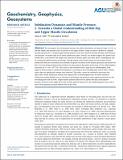Subduction Dynamics and Mantle Pressure: 2. Towards a Global Understanding of Slab Dip and Upper Mantle Circulation
Author(s)
Holt, Adam F; Royden, Leigh H
DownloadPublished version (6.941Mb)
Publisher Policy
Publisher Policy
Article is made available in accordance with the publisher's policy and may be subject to US copyright law. Please refer to the publisher's site for terms of use.
Terms of use
Metadata
Show full item recordAbstract
©2020. American Geophysical Union. All Rights Reserved. We investigate the relationship between the global distribution of deep slab dips (at 250- to 300-km depth) and pressure and circulation in the upper mantle. Using an analytic method to compute dynamic pressure in a 3-D global upper mantle domain, and a force balance between slab dip, slab buoyancy, and pressure, we model dips for all major subduction zones. Overall, our models suggest that global-scale mantle flow, as dictated by the shapes and velocities of Earth's plates and slabs, plays a fundamental role in creating the global pattern of slab dips. The dip trends of the South American and western Pacific subduction zones are controlled, in our models, by spatial variations in the dynamic pressure associated with flow. Our best fitting models produce global root mean square dip misfits of less than 10° for asthenospheric viscosities of 2.5–4.0 × 1020 Pas. This result is only obtained with a large flux of asthenosphere from upper to lower mantle at subduction boundaries, occurring on the overriding plate side of slabs, without which dips are significantly steeper than observed. This effect cannot be resolved by processes that affect only certain subduction systems and requires flux of asthenosphere into the lower mantle at subduction systems globally (or an alternative mechanism that produces more negative pressures on the overriding plate side of slabs). Upper mantle pressure fields that fit global slab dips yield negative dynamic pressure on the upper plate side of slabs, positive pressure on the subducting plate side, and an east-to-west pressure increase beneath the Pacific Plate.
Date issued
2020Department
Massachusetts Institute of Technology. Department of Earth, Atmospheric, and Planetary SciencesJournal
Geochemistry, Geophysics, Geosystems
Publisher
American Geophysical Union (AGU)